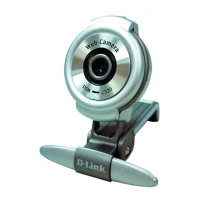
Do you have a question about the D-Link DSB-C320 and is the answer not in the manual?
| Resolution | 640 x 480 |
|---|---|
| Frame Rate | 30 fps |
| Interface | USB 2.0 |
| Lens | Fixed Focus |
| Microphone | Yes |
| Connectivity | Wired |
| Image Sensor | CMOS |
| Max Resolution | 640 x 480 |
| Focus Type | Fixed |
| Built-in Microphone | Yes |
| Cable Length | 1.5 m |
| Compatibility | Windows |
Lists the minimum hardware and software specifications needed to run the camera and bundled software.
Provides a brief overview of the D-Link DSB-C320 PC Camera and its capabilities.
Highlights the key features and advantages of the PC camera, such as resolution and design.
Explains how to adjust the camera's settings, like frequency, to avoid blurry images.
Provides step-by-step instructions for downloading and installing MSN Messenger on Windows.
Guides users on how to initiate a video conversation using the PC camera within MSN Messenger.
Details the process of installing the bundled Arcsoft software from the CD-ROM.
Introduces the application panel and how to launch Arcsoft applications.
Describes functions within the File, Edit, Preferences, and Help menus for software operation.
Explains the functions of buttons like Rotate, Email, Print, New Folder, and Delete.
Describes how to view and navigate through captured images and videos in the My Captures section.
Details player controls, chat tab, web camera settings, and show/hide captures.
Introduces VideoImpression for creating and sharing home videos, VCDs, and slide shows.
Explains video construction via storyboard and initial project setup.
Details selecting and adding media files like images, videos, and sound clips to the storyboard.
Explains the storyboard for video clips, transitions, and audio tracks.
Instructs on adding media components from albums to the storyboard.
Describes how to remove components from the storyboard using the trash can icon.
Explains player controls for previewing clips and the entire movie.
Guides on basic editing steps like modifying brightness and contrast of images/clips.
Details how to set the duration for still images within the video.
Guides on adjusting the start and end points of video and audio clips.
Explains how to adjust the volume levels for audio clips in the video.
Covers adding scene transitions and themes to enhance the video.
Describes how to add and format text overlays on video components.
Details the process of recording narration and adding it as an audio track.
Guides on saving the movie as a VCD for playback on DVD players.
Explains slide show creation is similar to video, covering overview and initial setup.
Details adding images and other media to the storyboard for a slide show.
Covers adding transitions, soundtracks, and narration to slide shows.
Guides on saving slide shows in EXE format, noting they are not for DVD players.
Offers advice on experimenting, using albums, sample content, and saving often.
Explains getting photos from folders, cameras, or albums, and the Get Photo module's purpose.
Details using the Mini Browser and different view modes for photos.
Covers rotating, flipping photos, and using the freehand crop tool.
Guides on improving photos with brightness, contrast, red-eye removal, and resizing.
Explains how to use the Clone tool to copy and paint over image areas or duplicate objects.
Explains how to add, move, resize, and rotate clip art images.
Guides on adding and formatting text, including shadows, to photos.
Details creating calendars, photo books, and printing photos with various layout options.
Guides on sending photos via email, selecting size, and choosing an email application.
Introduces Funhouse for creating unique images by combining photos with templates.
Explains selecting templates and inserting photos into masked areas.
Covers adjusting inserted photos and adding text with formatting options.
Details print preview, saving images, and emailing completed Funhouse images.
Guides on creating new templates and modifying masks using various tools.